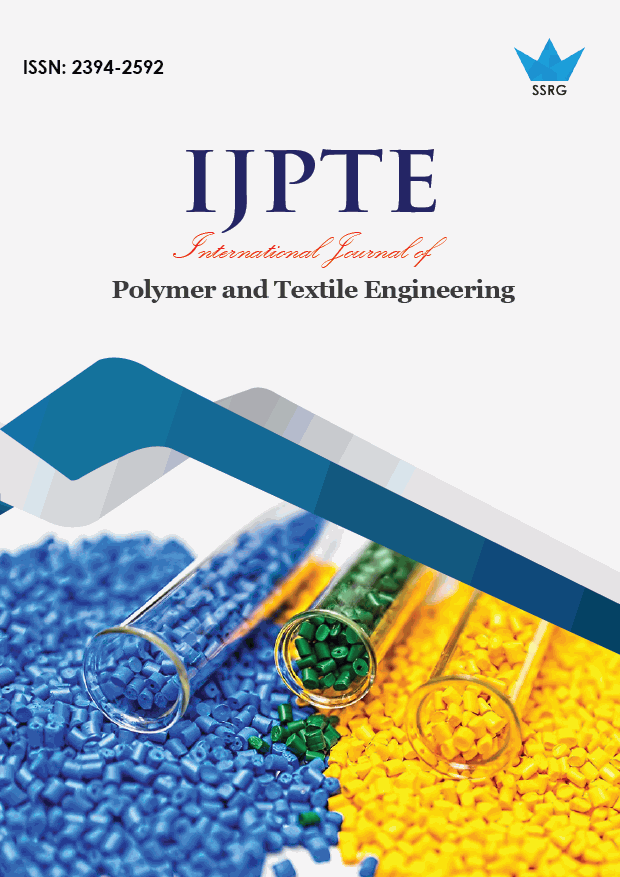Antibacterial Properties of Plant-Based Textiles

| International Journal of Polymer and Textile Engineering |
| © 2021 by SSRG - IJPTE Journal |
| Volume 8 Issue 2 |
| Year of Publication : 2021 |
| Authors : Nsangou Abdouramane, Nkemaja Dydimus Efeze, Pierre Marcel Anicet Noah, Fabien Ebanda Betene, Hambaté Gomdjé Valery, Yaka Nsasso Rhode christelle, Mewoli Armel |
How to Cite?
Nsangou Abdouramane, Nkemaja Dydimus Efeze, Pierre Marcel Anicet Noah, Fabien Ebanda Betene, Hambaté Gomdjé Valery, Yaka Nsasso Rhode christelle, Mewoli Armel, "Antibacterial Properties of Plant-Based Textiles," SSRG International Journal of Polymer and Textile Engineering, vol. 8, no. 2, pp. 1-5, 2021. Crossref, https://doi.org/10.14445/23942592/IJPTE-V8I2P101
Abstract:
The current trend of increasing respect for nature requires biodegradability of textiles and non-polluting products for textile finishing. The present study aims to make a synthesis of the knowledge on antimicrobial plant-based textiles and natural antibacterial treatment of textiles in the literature. The methodology carried out was to search articles, theses, and dissertations available in databases such as (Science Direct, EiCompendex, Inspec and Web of Science, and Google scholar) that deal with the issue of antibacterial textiles of plant origin. The results obtained show two types of textiles: natural antibacterial and non-natural antibacterial. Many antibacterial test works show that E coli is a bacterium that is inhibited by many natural antibacterial textile fibers. A non-antibacterial textile can become antibacterial after treatment with natural antibacterial substances. Also, an antibacterial fiber can be reinforced with antibacterial properties by other antibacterial agents. Several antibacterial substances have been proposed for the antibacterial treatment of textiles, namely: tea tree oil, Neem, eucalyptus oil, and albizia extracts, but have not yet been tested.
Keywords:
Antibacterial textile, antibacterial plant textile, and antibacterial textile agents
References:
[1] Bernard Martel,christine campagne et NemeshwareeBeharyMassika., Quand les textiles soigne,médecine/sciences,33 (2017) 73-80
[2] Claude Fauque, Sophie Bramel., Une seconde peau. Fibres et textiles d’aujourd’hui, Editions Alternatives.Internet: les vêtements communicants de FranceTélécom.www.francetelecom.com/fr/groupe/rd/une/videotheque/videos/vetement_com.html, (2005).
[3] Francois, NR., Jeanne, D., Hugues, AM. et Jean,F., Les textiles antibacteriens. NOSOCO.tech, laboratoire de pharmacie- laboratoire de microbiologie 8 avenue Rockeffer 69373 Lyoncedex, (2004).
[4] Élise Chadeau., Caractérisation des propriétés antibactériennes de textiles fonctionnalisés avec del’argent ou du PolyHexaMéthylène Biguanide (PHMB). Autre. Université Claude Bernard - Lyon I,2011. Français.ffNNT : 2011LYO10030ff.fftel-00848612, (2011) 260-261.
[5] Chadeau E., Caractérisation des propriétés antibactériennes de textiles fonctionnalisés avec de l’argent ou du PolyHexaMéthylène Biguanide (PHMB. Université Claude Bernard - Lyon I, Français. NNT: 2011LYO10030. tel-00848612, (2011).
[6] Mouna Messaoud., Fonctionnalisation anti-bactérienne passive ou active de tissus textiles par voiesol-gel ou photochimique - L’association du TiO2 et de la chimie douce. Autre. Université GrenobleAlpes. Français.ffNNT : 2011GRENI009ff.fftel-00584376ff. (2011) 141-142.
[7] Alejandra, R.,Contreras and coll polymer degradation and stability. Enzymatic degradation of poly (3-hydroxybutyrate –CO4-hydroxybuturate) by commercial lipases, (2012).
[8] Ambomo,M., De la lute contre les changements climatiques a la protection des droits de l’homme dans: Cahier africain des droits de l’homme 13, Developpement durable en Afrique, yaounde, presses de l’UCAC, ( 2016) 71-91.
[9] Nkemaja DE., Murgesh K., Njeugna BK., Vrushabhendrappa E.Y.,SidaRhombifolia – a natural fibre good for textile and craft industry.Textile Asia, 43 (2012) 16-19.
[10] NkemajaDydimusEfeze, NantiaAkono,E., MurugeshBabuNjeugnaEbenezer,K. Murugesh and ZipoRodulf., Studies on antibacterial properties of SidaRhombifolia plant, International Journal of Current Research,10(10) (2018) 74412-74415. DOI: https://doi.org/10.24941/ijcr.32454.10.2018.
[11] Hetal M., Suman M., andAnju T., Antibacterial Treatment on Cotton Fabric from Aloe Vera . Department of Textiles and Apparel Designing, Sir VithaldasThakersey College of Home Science [Autonomous], Juhu, S.N.D.T Women’s University Mumbai - 400049, [Maharashtra] India, (2020).
[12] Poutoum YI.,Activité des extraits d’albiziazygia (fabaceae) sur les bactéries escherichia coli et salmonella typhi en microcosme aquatique: influence de quelques facteurs abiotiques. Mémoire Présenté En Vue de l’Obtention du Diplôme de Master en Biologie des Organismes Animaux Universite de Yaounde I Departement de Biologie Et Physiologie Animales, (2019).
[13] Nsangou A., Traitement antibactérien des fibres de sida rhombifolia par l’aloevera en vue d’application textile. Mémoire soutenu en vue d’obtention du diplôme de Master recherche en science de l’ingénieur,Université de Douala, (2020).
[14] Joyshree A. and Vasugi N., Extraction OfNeem Twigs Fiber, SSRG International Journal of Polymer and Textile Engineering (SSRG-IJPTE) – 7(1) (2020).

 10.14445/23942592/IJPTE-V8I2P101
10.14445/23942592/IJPTE-V8I2P101